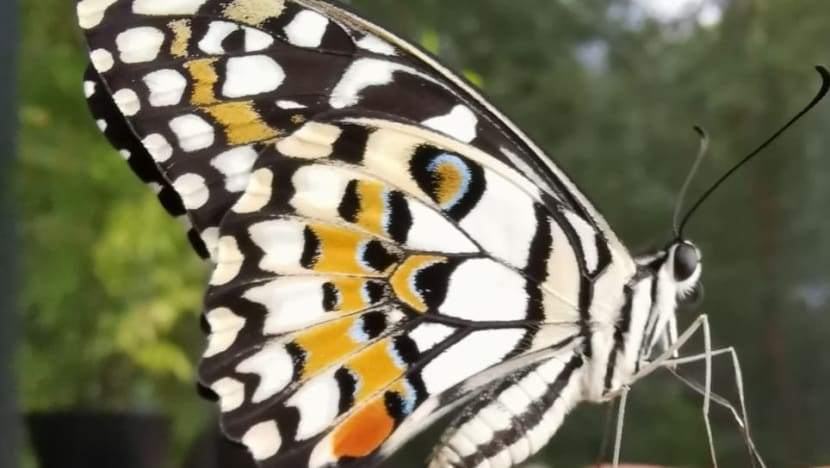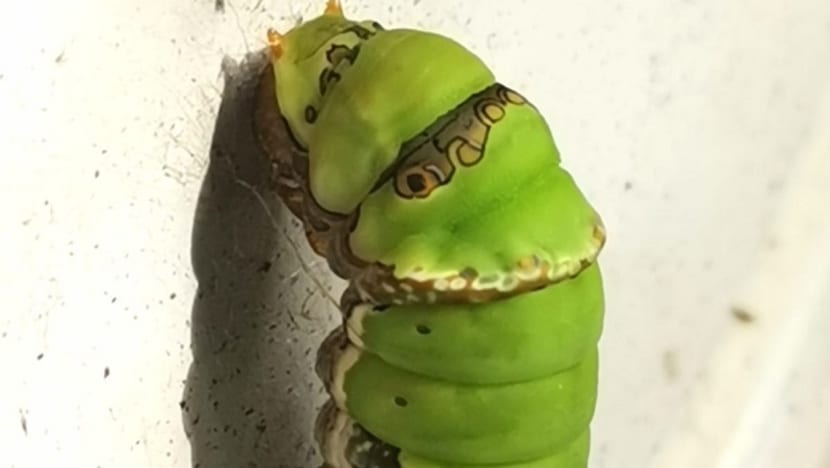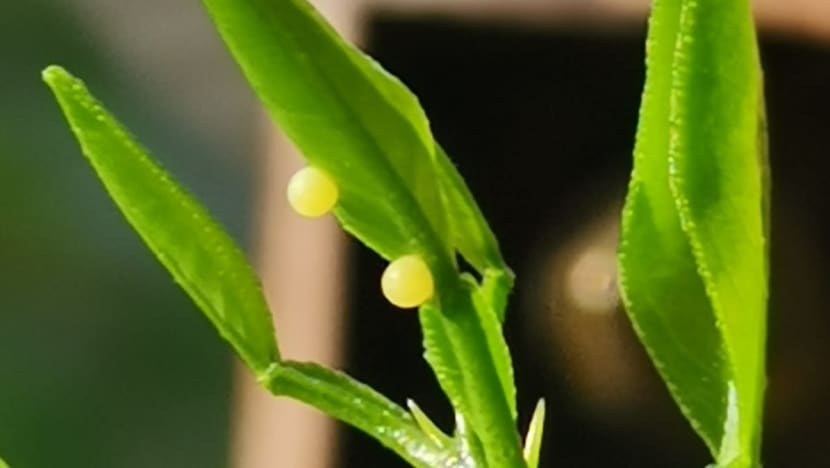Commentary: Raising caterpillars has been a life-changing pandemic hobby
After staying in so much these past one and a half years, many of us have discovered new hobbies and passions, some weirder than others, says Tracy Lee.

A fully grown lime butterfly, or Papilio Demoleus, is named because it lays eggs on citrus plants. (Photo: Tracy Lee)
SINGAPORE: Thanks to COVID-19 restrictions, the entire country found itself spending unprecedented amounts of time at home.
Many doomscrolled their way through hazy days. Others whiled away their non-work hours with cooking, growing plants, decluttering, playing video games, watching their umpteenth Korean drama, or baking.
Homegrown baking supplier Phoon Huat managed to open four new stores in 2020, and reported that a drop in its business to business revenue was recovered by robust retail sales.
Clearly baking was a big winner.
I became a crazy caterpillar lady. It all started innocuously enough.
My partner was on the balcony watering and talking to plants while keeping an eye out for mealybugs and millipedes. That was his new pandemic hobby – gardening.
He checked the plant carefully, remarking that something had been eating holes in its leaves, then exclaimed disgustedly: “Ugh, it’s this ugly caterpillar”.
With its mottled grey-khaki-rust colourway, the spiky, 1.5 cm-long critter was definitely lacking in the cuteness department. More precisely, it resembled bird poop.
“How do I get rid of it without killing it?” he wondered out loud.
“Wait! Caterpillars become butterflies, no? And butterflies help pollinate plants? Let’s keep it,” I suggested.
He protested on account of his poor lime plant. But this was where Google came to the rescue.
I whipped out my smartphone, googled “Lime+Caterpillar”, and out popped several blogs and Youtube videos documenting the transformation of the genus known as Papilio Demoleus.
This is a common species of butterfly which is also known as a lime butterfly – on account of where they lay their eggs – in this case, the lime plant.
They start as tiny round yellow eggs, to bird poop-like caterpillar, to flashy green worm with graphic black markings, to cute gummy-bear-sized cat-shaped chrysalis, and finally, to a beautiful butterfly with dramatic black, brown and white markings, red and blue spots, and a furry, black-and-white striped body.
I was determined to see if I could raise a butterfly from infancy.
After minutes of tense negotiation, it was agreed the caterpillar would be evicted from the lime plant and housed in a glass jar, within a plastic box with ventilation holes drilled into it. I was grudgingly allowed to harvest lime leaves to feed it as needed.
And so began my love affair with my first very hungry caterpillar.

WHEN A HOBBY BECOMES ALL-ENCOMPASSING
Soon enough, I found myself checking in on it several times a day, carefully selecting the tenderest young lime leaves to feed it with, zooming in with my smartphone camera’s Super Macro lens for close-ups and charting its growth.
I’d research what was supposed to happen next in terms of its developmental timeline, to make sure it was doing fine. I took countless proud pictures and videos of it eating and walking around.
Once, I even spritzed it with water to see its osmeterium, a red, fleshy, forked appendage that lime caterpillars stick out from the backs of their heads when they’re annoyed, in action.
Soon after, we discovered two other caterpillars nibbling at our plants. Of course, I took them under my wing too, feeling like a mini lepidopteran version of Daenerys Targaryen, Mother of Dragons, from cult HBO series Game of Thrones.
Just by watching them morph, I learnt just how amazing nature was. Did you know that after caterpillar transforms into a chrysalis, its internal organs liquefy before reconstituting themselves into butterfly parts?
And that the butterfly emerges about 10 days later? I became so obsessed with trying to catch the exact moment this happened, that I placed the glass jar right next to my bedside table, eyeballing the chrysalis till 2am.
But the action took place while I was sleeping — I woke up the next morning to find the butterfly flapping beautifully in its box. I filmed it, then set it free.
The arrival of the second and third butterflies were equally, thrillingly soul-satisfying, but after I released them, I felt strangely bereft.
Days later, two of the winged insects paid a flying visit to our lime plant and laid several eggs on its leaves, as if to say “we trust you with our future generations!”. They hatched and so the cycle began again. Since then, I’ve raised several more butterflies from scratch.
TAPPING INTO A SOCIAL NETWORK
I don’t think I’ve ever been considered weird, eccentric or geeky by any of my family or friends, but this was probably the point when perceptions changed.
After posting my butterfly chronicles on social media, some old friends I hadn’t heard from in a while got in touch — and to think all this while, I never knew there were so many fellow caterpillar enthusiasts out there.
As American website refinery29.com noted: “One way that many people are filling their at-home time is by exploring hobbies with a fervour once reserved for, well, all the other stuff they used to do ... this has led to a new trend in social media: The hobby humblebrag”, which it describes as “part nesting impulse, part distraction, and partially born out of a need for something to help define us”.
A retired ex-colleague, a former top fashion photographer who used to snap portraits of the likes of Zoe Tay and Fann Wong, got in touch with pictures of his own caterpillars, but needed advice on why they kept disappearing into thin air before he got any butterflies out of them.
An old childhood friend texted me pictures of his wife's butterflies, as well as the multiple caterpillar/butterfly enclosures he has designed and made using his new toy, a very expensive 3D printer — that's his pandemic passion.

Some people have even turned their pandemic passions into businesses. According to The New York Times, a recent survey by online loan marketplace LendingTree found that six in 10 respondents started a hobby during the pandemic; nearly half of them have earned money, turning it into a side hustle.
But that thought never crossed my mind, because I feel my caterpillars are a gift from nature.
I decided I would gift some of the caterpillars (or chrysalises, which are a lot more idiot-proof as, being in a state of suspended animation, they require no feeding) to friends with young children, so they can learn about insect life cycles, and experience the joy of waking up to a butterfly.
A psychologist friend recently wanted my butterfly photos and videos so she could show them to her grandkids. “Butterflies symbolise rebirth, transformation, freedom, change, hope and life. So why not take time to reflect about all the positive changes in your life these past few years?” she said.
And indeed, for so many of us this year-and-a-half has been transformative – whether in the way we lived or worked and certainly in the way we sought play. Unlike the butterfly, we are grounded, unable to take flight.
But in this new pandemic passion, I have found that everything has its own time. Just as much as I cannot rush the cycle of life, we need to wait out storms and slowly but surely, we may be able to finally fly free.
Tracy Lee is a freelance writer who writes about food, travel, fashion and beauty.















